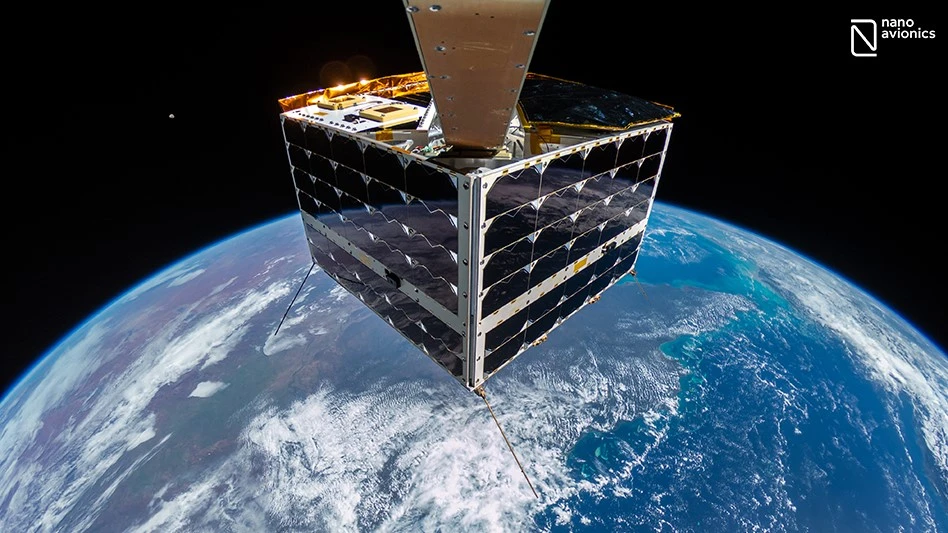
NanoAvionics
Global mission integrator NanoAvionics added two microsatellite buses, the MP42H and the MP42D, to its product line based on its flagship MP42 bus. Capable to host customer payloads of up to 145kg and a total satellite mass of up to 220kg, the company has now one of the widest ranges of commercially available modular microsatellite buses in the industry.
Designed to significantly reduce mechanical constraints for payload integration, the satellites across the new bus range are variously ideal for more sophisticated missions in the fields of remote sensing, high data throughput and complex communications missions, emergency communications, fundamental research, and as orbital transfer vehicles (OTV).
All MP42 microsats are equipped with NanoAvionics’s next generation payload controller. The controller allows customers to build their own software blocks. The microsats provide intersatellite link for both LEO-LEO and LEO-GEO, ensuring uninterrupted real time communications. For communications missions, all MP42 buses provide customers with options to tailor the satellites for their bandwidth and constellation coverage needs. The successful heritage mission for this microsat range, a prototype of the MP42, flew into orbit aboard a Falcon F9 in April this year.
“More and more customers require sophisticated missions and applications which in return demand flexible buses designed and equipped to host their larger payloads while keeping cost low,” says Vytenis J. Buzas, founder and CEO of NanoAvionics. “With our newly extended range, based on our flight proven MP42 bus, and together with our mission operations and launch brokering, we are offering the perfect solution to allow these companies to get their operational satellites into orbit quickly, safely, and cost-effectively. The extension is also the logical next step of our strategic decision to expand into the microsatellite market that was based on reduced costs in the launcher segment, allowing heavier payloads because of that. A development that we are seeing across the whole industry.”

The use for advanced missions and applications is a result of their modular design and being optimized to offer flexible envelopes to host customer payloads of up to 145kg and a total satellite mass of up to 220kg. Their design significantly reduces mechanical constraints for payload integration. This gives customers freedom for the shape and volume of payloads, without interfering with the satellite frame, lowering costs for development and payload integration and improves lead times and reliability.
Overall cost and lead times are lowered by the standardized design that keeps 80% of the satellite’s architecture for any customer mission. It enables NanoAvionics to manufacture parts in larger quantities in advance. Microsatellite buses are part of an end-to-end mission infrastructure for single missions and for constellations, including launch and logistics, ground station network, and mission operations.
Equipped with optional EPSS enabling propulsion system for small satellites, the satellites perform high-impulse maneuvers including orbit maintenance, precision flight in formations, orbit synchronization, atmospheric drag compensation, and in certain cases even orbital deployment. This results in extended satellite orbital lifetime significantly reducing cost for replacing constellation satellites.
The microsatellite bus range (all sizes and dimensions depend on customer required configurations)
• The smallest bus in the range is the MP42H with an empty bus mass starting at 18kg and a payload envelope beginning at 280 x 325 x 280mm, accommodating payloads of up to 22kg.
• The MP42, sitting in the middle, has an empty bus mass starting at 45kg with a payload envelope beginning at 490 x 480 x 350mm, and capable to accommodate payloads of up to 75kg.
•At the top of the range is the MP42D with a total empty bus mass starting at 70kg and a payload envelope starting at 740 x 730 x 500mm, accommodating payloads of up to 145kg.
The final satellite height of all three buses can be adjusted up to 1300mm to accommodate larger payload requirements, required for new commercial exploration and more cost-effective research missions in LEO.
The MP42D‘s increased payload envelope and its greater antenna width also makes it ideal for remote sensing applications. The antenna improves ground-range and azimuthal resolution (the angle or distance by which two targets must be separated to be distinguished by a radar set, when the targets are at the same range), peak transmission power, pulse duration, and noise bandwidth. The increased envelope enables optical imaging payloads with a ground sampling distance of 0.5m or less.
Latest from Aerospace Manufacturing and Design
- NCDMM soliciting RFI on advancing metal alloy systems, processes
- Meet the challenges of the manufacturing supply chain
- Deutsche Aircraft selects Honeywell HF radios for D328eco
- MAPAL's BFS connection for replaceable head milling systems
- Happy Thanksgiving
- Renishaw's CARTO software
- TRIGO ADR Americas partners with NDT Solutions, NDE Labs
- Horn's deep axial grooving insert





